‘Algae’ is an umbrella term for a large group of aquatic organisms with the ability to photosynthesize. The phrase ‘Harmful Algal Blooms’ (HABs) refers to algae growing excessively and releasing algal toxins, most commonly microcystins, into their aquatic habitat as they proliferate. In Michigan, most HABs are due to the abundance of blue-green algae, or cyanobacteria. However, it is important to note that just because a cyanobacteria bloom is present, it does not mean that it is producing toxins. The only true way to tell if an algal bloom is toxic is by sending it to a laboratory for analysis.
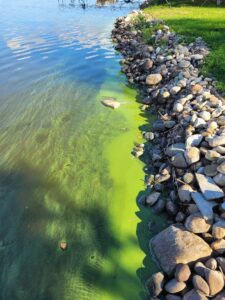
HABs typically occur when there is an abundance of sunlight, nutrients, and warm weather in a slow-moving body of water, such as a lake or pond. While HABs can happen naturally, it is often human activity that spurs bloom formation. Poor septic system management, introduction of invasive species, and removal of shoreline vegetation can increase nutrient levels in a nearby body of water and make it more susceptible to HABs. In addition to this, farmers that allow irresponsible fertilization practices, as well as golf courses, homes, or businesses that overapply fertilizers, are additional sources of nutrient influx in waterbodies.
Human-driven climate change is also a contributing factor to the formation of HABs – industrial carbon emissions, transportation, and deforestation are slowly increasing the planet’s average temperature, increasing the likelihood of HABs worldwide. This likelihood increases because toxic algae thrive in warmer waters. Warmer waters prevent mixing, allowing algae to proliferate at a more rapid pace. Furthermore, algal blooms absorb sunlight, increasing water temperatures even further and leading to a cycle of unwanted growth.
Furthermore, HABs are an issue close to home for many Michiganders – Lake Erie is a famous example of a body of freshwater that experiences HABs fairly frequently. These HABs are often so extreme that they are visible from space.
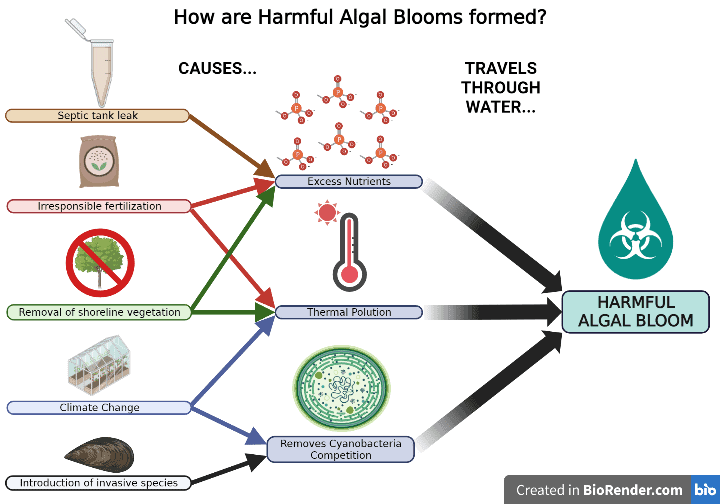
HABs typically have an oily sheen, discoloration in the form of green or blue streaks, and can often look like bright green paint spillage on the surface of a waterbody. HABs may also have a foamy or scummy texture and can form floating globs. Oftentimes, filamentous algae, pollen, and duckweed (Lemnoideae) are mistaken for HABs. Filamentous algae, such as Cladophora, look like green clumps of thread or hair. Duckweed are tiny floating plants capable of covering the surface of waterbodies. Pollen blows from surrounding trees and plants into waterbodies, sometimes staining the water a yellowish color. Neither filamentous algae, duckweed, or pollen are capable of producing toxins.
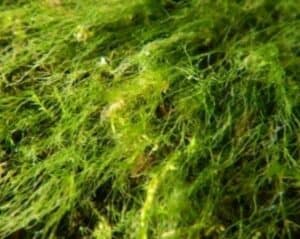
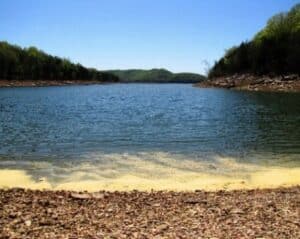
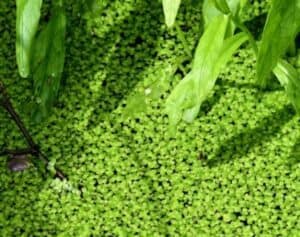
HABs have serious impacts on human health, pets, and the environment. A variety of dangerous toxins are released from HABs, including endotoxins that can cause headaches, gastrointestinal distress, and skin irritation, hepatoxins that can cause liver damage or failure, and neurotoxins which can cause brain damage, paralysis, and respiratory failure. Furthermore, toxins released from HABs can persist in a body of water for years following their initial release, accumulating in precious water resources and disrupting pristine freshwater environments. HABs also deplete the oxygen content in water, forming hypoxic zones and leading to fish die-offs.
While HABs can be devastating to both humans and aquatic ecosystems, there are measures that can be taken to prevent HABs. Planting native vegetation along a shoreline (see Greenbelts for more information) or in your yard (see Rain Gardens for more information) is an effective way to prevent HABs. This native vegetation can filter out excess nutrients that may make their way from groundwater into a nearby body of water and doesn’t typically need to be fertilized. If you don’t own property on a shoreline or property with a yard, you can advocate for local policy limiting the use of fertilizers in agriculture or on lawns and educate others on the causes, dangers, and preventative measures for HABs.
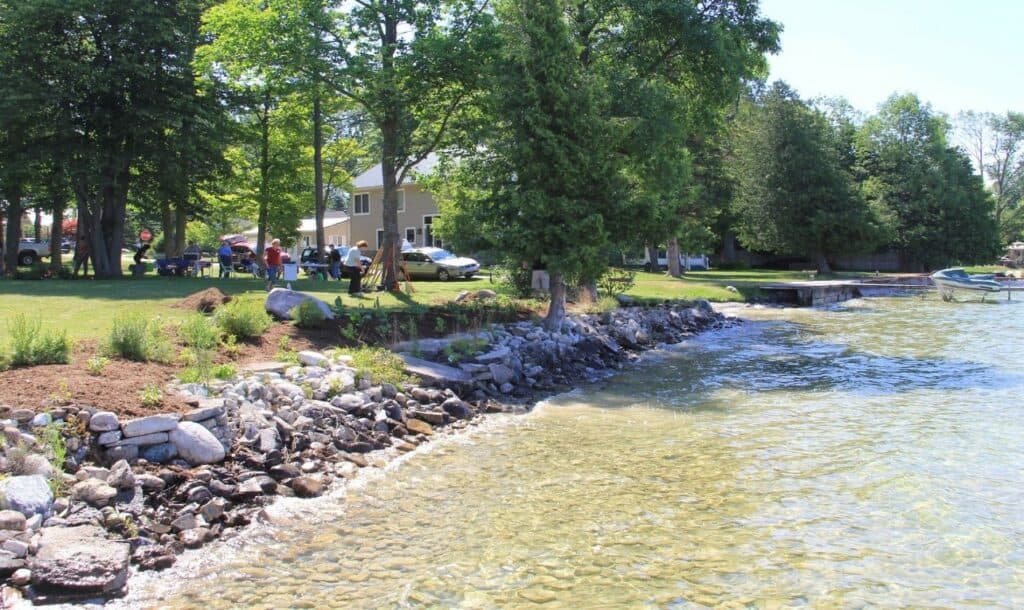
Mitigating the spread of invasive species can further prevent HABs, as invasive species can completely disrupt a waterbody’s pre-existing food web. For example, the recent population boom from invasive mussels can exacerbate HABs when these organisms feed on particles and then ‘spit out’ the undesirable blue-green algae into the surrounding water. These non-native mussels also feed on algal species that typically serve as competition for cyanobacteria, allowing cyanobacteria populations to flourish.
Again, if you see suspicious looking algae, do NOT touch it – it is not possible to know for sure if an algal bloom is toxic without confirmed laboratory results. If you believe you have found a HAB, contact the Environmental Assistance Center at the Michigan Department of Environment, Great Lakes, and Energy (EGLE) at 1-800-662-9278 or email AlgaeBloom@Michigan.gov. We all care about our Michigan freshwaters and depend on them for drinking, recreation, aesthetics, and countless ecosystem services. Thus, preventing HABs in local bodies of water should be viewed as both a personal and community responsibility.
Additional Resources:
See the link below to view a map of reported HABs and/or cyanotoxin presence in the state of Michigan:
https://mdhhs.maps.arcgis.com/apps/webappviewer/index.html?id=b05d6b7498ca4ce29a586f1f2b9cefeb
See the following videos for helpful tips to identify HABs:
EGLE Classroom – Identifying Harmful Algal Blooms (Cyanobacteria) – YouTube
How to Identify Harmful Algal Blooms (HABs): Tips and Tricks – YouTube
References
Amin, M. N., Kroeze, C., & Strokal, M. (2017). Human waste: An underestimated source of nutrient pollution in coastal seas of Bangladesh, India and Pakistan. Marine Pollution Bulletin, 118(1–2), 131–140. https://doi.org/10.1016/j.marpolbul.2017.02.045
Ballard, L., & Hovorka, D. (n.d.). Algal Blooms: The Causes, Dangers and Some Solutions. Izaak Walton League of America. https://www.iwla.org/publications/outdoor-america/articles/outdoor-america-2020-issue-2/algal-blooms-the-causes-dangers-and-some-solutions
Bláha, L., Babica, P., & Maršálek, B. (2009). Toxins produced in cyanobacterial water blooms – toxicity and risks. Interdisciplinary Toxicology, 2(2). https://doi.org/10.2478/v10102-009-0006-2
Butler, N., Carlisle, J. C., Linville, R., & Washburn, B. (2009). Microcystins: a brief overview of their toxicity and effects, with special reference to fish, wildlife, and livestock. California Environmental Protection Agency, Sacramento, 5.
Centers for Disease Control and Prevention. (2023, May 25). Avoid harmful algae and cyanobacteria. Centers for Disease Control and Prevention. https://www.cdc.gov/habs/be-aware-habs.html
Environmental Protection Agency. (2022, December 15). Climate Change and Harmful Algal Blooms. EPA. https://www.epa.gov/nutrientpollution/climate-change-and-harmful-algal-blooms#:~:text=Warmer%20water%20due%20to%20climate%20change%20might%20favor,making%20water%20even%20warmer%20and%20promoting%20more%20blooms.
Environmental Protection Agency. (n.d.). EPA. https://www.epa.gov/nutrientpollution/climate-change-and-harmful-algal-blooms
Environmental Protection Agency. (n.d.). Sources and Solutions. EPA. https://www.epa.gov/nutrientpollution/sources-and-solutions
Tip of the Mitt Watershed Council. (n.d.). Greenbelts. https://www.watershedcouncil.org/greenbelts.html
Michigan Sea Grant. (2023). Harmful algal blooms. https://www.michiganseagrant.org/topics/coastal-hazards-and-safety/harmful-algal-blooms/#:~:text=Some%20scientists%20also%20link%20the%20increase%20of%20HABs,release%20blue-green%20algae%20back%20into%20the%20water%20intact.
SOM – State of Michigan. (n.d.). Harmful algal blooms. https://www.michigan.gov/egle/about/organization/water-resources/assessment-michigan-waters/harmful-algal-blooms
Joyce, S. (2000). The dead zones: Oxygen-starved coastal waters. Environmental Health Perspectives, 108(3). https://doi.org/10.1289/ehp.108-a120
Lorditch, E. (2021, June 24). Are zebra mussels eating or helping toxic algae?. Phys.org. https://phys.org/news/2021-06-zebra-mussels-toxic-algae.html#:~:text=The%20researchers%20suspected%20the%20zebra%20mussels%20were%20consuming,under%20lower%20nutrient%20availability%20than%20it%20usually%20needs.
Watson, S. B., Whitton, B. A., Higgins, S. N., Paerl, H. W., Brooks, B. W., & Wehr, J. D. (2015). Harmful algal blooms. Freshwater Algae of North America, 873–920. https://doi.org/10.1016/b978-0-12-385876-4.00020-7
YouTube. (2022). EGLE Classroom – Identifying Harmful Algal Blooms (Cyanobacteria). YouTube. Retrieved August 16, 2023, from https://www.youtube.com/watch?v=9Es9IqHECaE&t=1s.
YouTube. (2019). How to Identify Harmful Algal Blooms (HABs): Tips and Tricks. YouTube. Retrieved August 16, 2023, from https://www.youtube.com/watch?v=8nL_s77FV-o.

